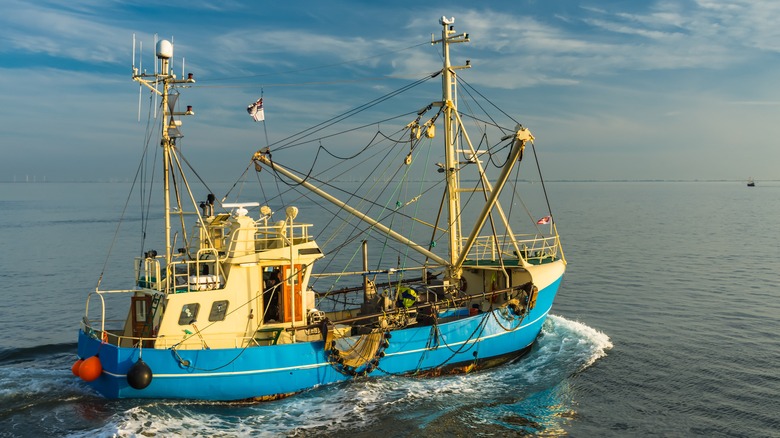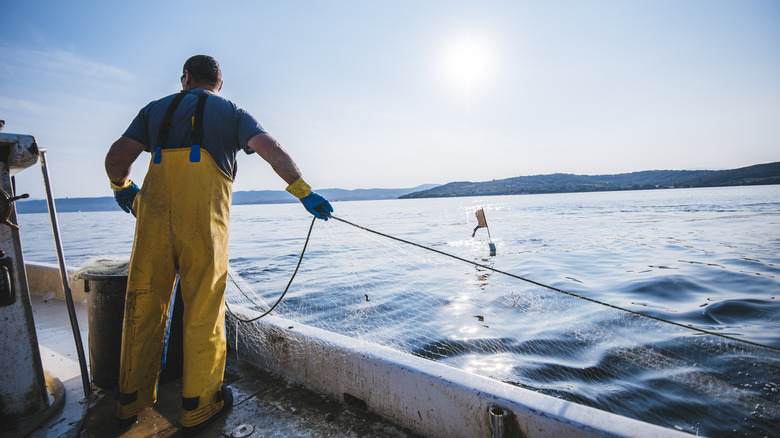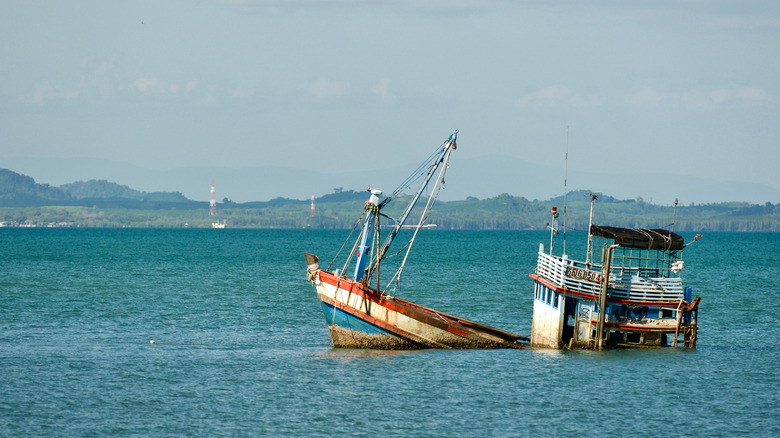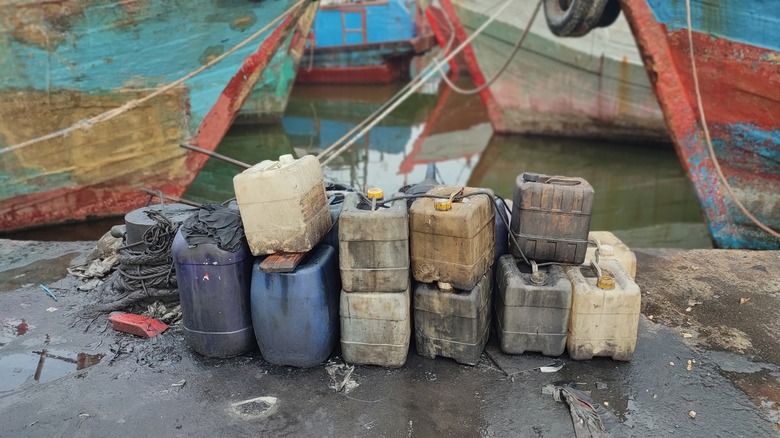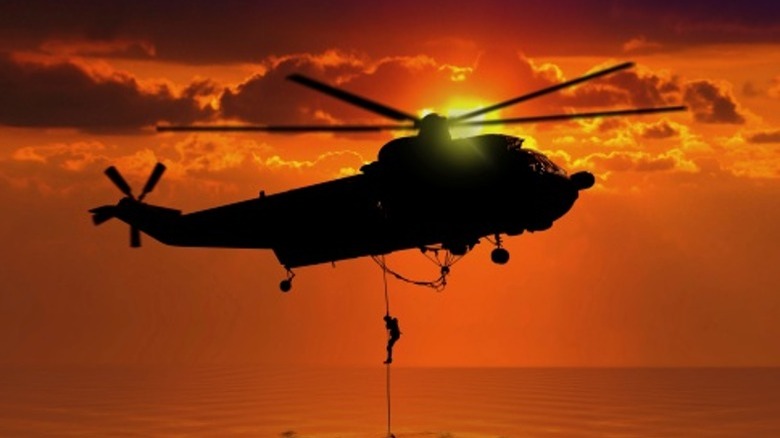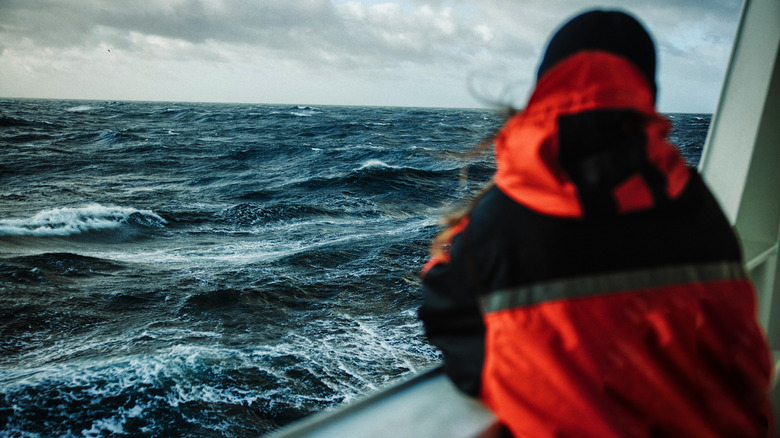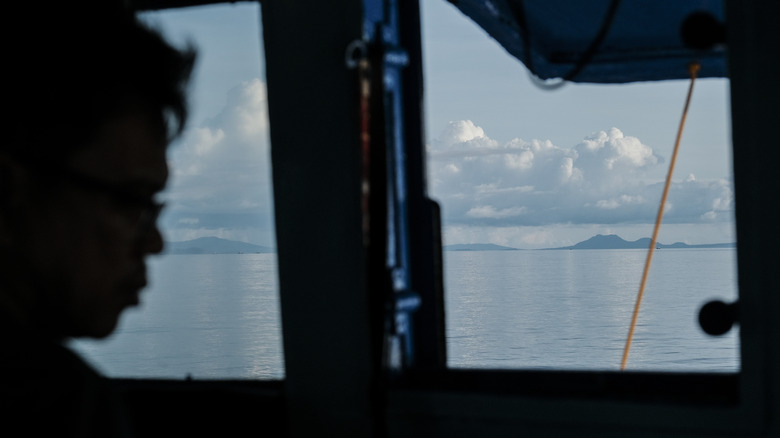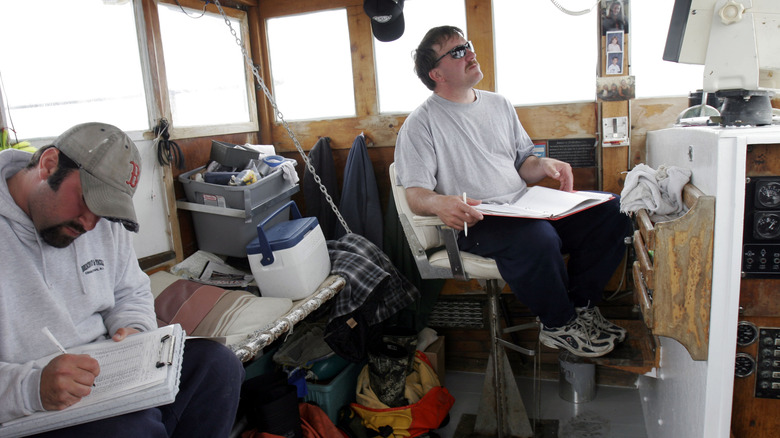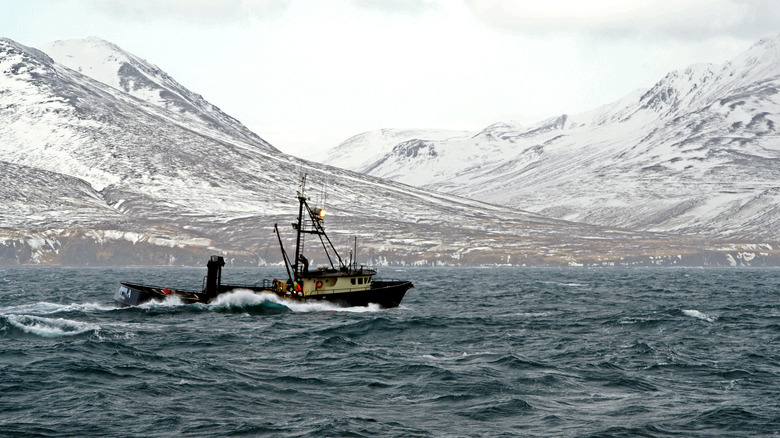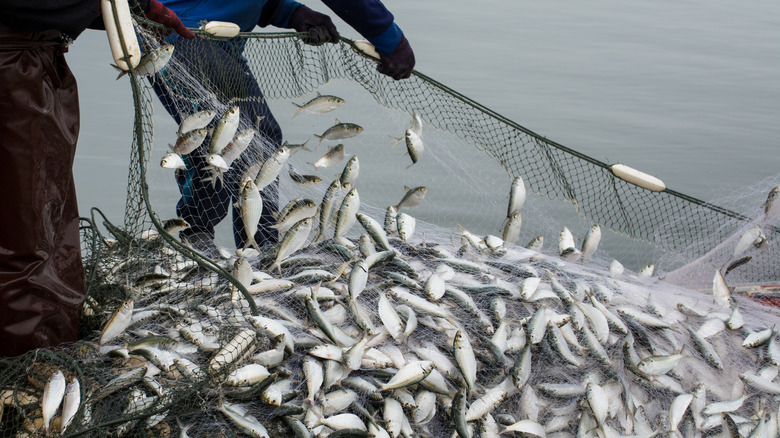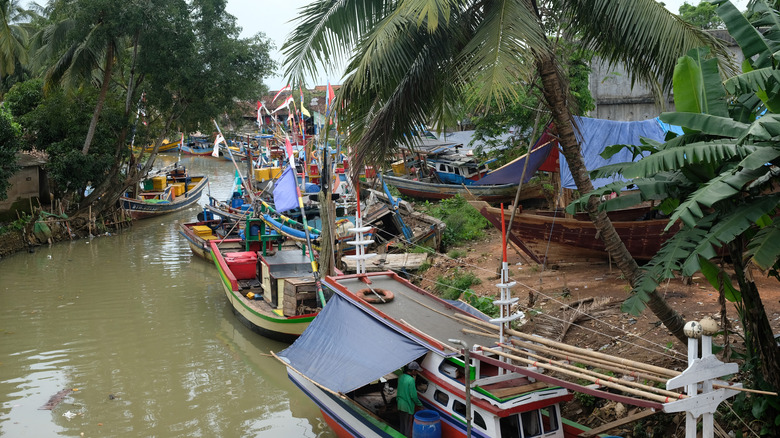Why Commercial Fishing Like Deadliest Catch Is So Dangerous
Even though viewers can tune in to "Deadliest Catch" and be fairly certain that networks, censors, and broadcasters aren't going to let real-life graphic violence make it onto the screen, there have been a number of deaths among the cast and crew — perhaps most famously the untimely passing of Cornelia Marie captain Phil Harris. His death was pretty shocking when it happened, and here's the thing: It's not unusual.
According to data compiled by the Centers for Disease Control and Prevention, around 43 people die on U.S. fishing boats every year — and that's a lower death count than many other countries. In 1999, the International Labour Organization found that the fishing industry claimed somewhere around 24,000 lives each and every year, making it one of the most dangerous jobs at the dawn of the 21st century. Has it gotten safer? Not exactly.
Fast forward to 2022, when a study by The Pew Charitable Trusts and the FISH Safety Foundation found that earlier numbers had been highly inaccurate. The annual death toll among fishermen and fishing boat crew members was actually in the neighborhood of around 100,000 people. And? It was only getting more dangerous, as more and more people were turning to fish as a sustainable and healthy option. That's not exactly great news, and it brings up a very important question: What the heck is going on here?
A fall overboard is often fatal
Fancy a nighttime stroll up on the deck of the boat? Take in the stars, perhaps, and enjoy the peace and quiet? That, it turns out, is a terrible idea. In a 2018 study cited by the Centers for Disease Control and Prevention, researchers analyzing data about falls overboard on commercial fishing vessels found that in 59% of cases, no one was around to see it happen. And "victim" is a pretty accurate term, because of those people who fell overboard, 89% were never seen again.
The CDC cited falling overboard as one of the leading causes of death among fishermen, and it's so deadly because of a combination of things. The good news is that most people aren't going to die of hypothermia, but the bad news is they're going to die even sooner. It takes just 10 minutes for a person submerged in cold water to start losing the ability to control their limbs, and that results in something that the CDC eerily terms "swimming failure."
That said, it's also worth noting that it's incredibly easy to actually fall overboard. When researchers compiled fall data for a study published in the American Journal of Industrial Medicine, they found cases where fishermen were pulled or pushed over by fishing gear, fell on a slippery deck, were washed over by a wave, pushed by adverse weather conditions, and got tangled in gear.
It's incredibly easy for ships to become unstable
Even those who spend a good part of their lives out on the ocean can find tragedy striking in a heartbeat. In May 2023, China announced that no one had survived when a fishing vessel carrying 39 people capsized a little over 3,000 miles off Australia's coast. It doesn't have to happen out in the deep ocean to be deadly, either: Just a few months prior, eight people died when two fishing boats capsized off the coast of San Diego.
A huge part of the problem is how easy it is for fishing boats to become unstable. According to the Royal National Lifeboat Institution, instability plays a part in around half of the fatal fishing accidents in the U.K. and Ireland. At a glance, it seems pretty obvious that boats need to be loaded in a way that's going to keep them upright, so why is it such a problem?
It's a combination of things. Fishing boats tend to be loaded down with all kinds of equipment, but that equipment isn't stationary. Add constantly moving gear to the weight of what's hauled on board and that means the boat's entire center of gravity is in pretty constant flux. Then, take the ever-changing outside forces. Wind, rain, unpredictable waves, and other weather conditions mean that it just takes a split second for a shifting crab pot and an unexpected wind gust to upset a delicate balance and an entire ship.
Ships are carrying incredibly dangerous chemicals
Fishing vessels don't have to capsize to kill those on board, and according to statistics compiled by the Centers for Disease Control and Prevention, the chemicals on board fishing vessels can very quickly turn a situation deadly, particularly in the enclosed spaces that are a part of everyday life on boats. And there are a lot of chemicals — from coolants and refrigerants to chemicals for boat maintenance, repair, and cleaning — that can kill in a variety of ways.
Guidelines from the Occupational Safety and Health Act (OSHA) for safely storing and using chemicals outline some of the problems that can occur, and most start to develop when workers go into enclosed spaces and use substances like ammonia or hydrogen sulfide. The release of gases and vapors can very quickly build up in small spaces to create an environment that isn't just low in oxygen, but that can be highly flammable. Foam insulation (which is commonly used for repairs), hydraulic fluid, oils, and Freon are all hazardous — and standard on fishing boats — and there's another possibly even worse scenario that also needs to be mentioned.
Fishing boats have tanks: sewage tanks, oil tanks, tanks to store their catch, and slop tanks. The contents of all of those tanks can give off fumes that result in low-oxygen environments, and for fishermen on cleaning, repair, or watch duties, one wrong step can mean a very terrible end.
Need a hospital? Good luck!
When there is an emergency on board a fishing vessel, help isn't just a quick phone call away. Depending on how far out to sea a vessel is, it could be a long, long time before emergency services can respond — and once they do, it's rarely a straightforward rescue.
Take one case outlined in a U.K. booklet published by the Marine Accident Investigation Branch. When they looked at cases and what went wrong, they looked at one incident where a rescue helicopter was trying to retrieve an injured fisherman from the deck of his boat. Winds made it impossible, and as he was being winched up to the helicopter, the crew had to cut the line to keep the fisherman from being crushed against the rail.
"Deadliest Catch" has shown some incredibly edge-of-your-seat helicopter rescues, and it's not something that's played for television. If anything, viewers get a condensed version of things: When Patricia Lee deckhand Francis Katungin was crushed by a crab pot, viewers didn't see the 16-hour journey the ship had to take to get within range of a rescue chopper that would take him to the hospital for what was believed to be a shattered hip and pelvis. And even when they got within range, conditions were so dangerous, they weren't sure if they were going to be able to make the pickup.
Some valuable fishing grounds come with deadly weather
Fans of "Deadliest Catch" will be familiar with some of the problems presented by the weather on the Bering Sea. Ice, snow, rain, freezing temperatures, and a combination of all of those things are the norm instead of the exception. And they're not alone in facing extreme weather on board fishing boats.
For commercial fishermen in the Gulf of Mexico, it's hurricanes that are the problem. Not only is there the danger of being caught out in the water, but there's the financial strain, too. Louisiana-based fishermen Randy Nunez talked to PBS about the devastation brought by Hurricane Ida, saying that his business, home, and livelihood were gone. "I can't put it in words. It was a total wipeout," he said.
Fishermen on the other side of the world have been finding themselves facing increasingly dangerous weather, too. In 2019, The Earth Journalism Network spoke with Drubadi Das, the wife of a fisherman who had drowned after his fishing boat was hit by a cyclone out in the Bay of Bengal. When they looked at the conditions he — and dozens of other fishermen — faced, they found it wasn't just increasingly erratic weather patterns that were the problem. Declining fish populations meant more trips taken for longer periods of time, farther out into more dangerous waters, with many feeling as though they have no choice but to ignore weather warnings and potentially dangerous conditions if they wanted to try to make ends meet.
Mental health care is a major concern
Fishermen deal with not only the constant stress of keeping themselves and their crew safe, but also economic hardships, the lasting — and inevitable — impacts of trauma and loss, the unpredictability of an industry overseen by ever-changing rules, and the pressure of knowing that the fish their livelihoods depend on are, in some cases, on the decline. Add in a lack of mental health resources specifically geared toward addressing the lifestyle and problems of fishermen, and it all combines to be too deadly, too often.
Monique Coombs is a mental health advocate working for the Maine Coast Fishermen's Association and says (via National Fisherman) that when suicide rates are broken down by industry, the commercial fishing industry is one of the hardest hit. She's been working with commercial fishermen to put mental health resources in place, but it's been an uphill battle against forces perhaps best summed up by the fishermen themselves.
Tom Santaguida has been fishing off the coast of Maine for nearly five decades, and those are five decades of 70-hour work weeks of back-breaking labor and increasing pressure. He explained to Hakai Magazine that the actual fishing was "probably the least stressful thing in my life. It's all the other stuff around it, the crazy government regulations, the bureaucracy you have to deal with just to be able to do your job, the unfunded mandates ... those are the things that are making us just collapse mentally as a group."
If you or someone you know needs help with mental health, please contact the Crisis Text Line by texting HOME to 741741, call the National Alliance on Mental Illness helpline at 1-800-950-NAMI (6264), or visit the National Institute of Mental Health website.
Conflict between fishermen and observers can turn deadly
Commercial fishermen aren't the only ones out on the high seas, and it's the job of fishery observers to monitor things like the stability and size of fish populations. They're also there to make sure rules and regulations are being followed, and if it seems like that's the perfect formula for conflict, that's because it absolutely is. In 2020, The Guardian spoke with Liz Mitchell, an advocate for the world's fishery observers. Deaths — but few answers — had been coming pretty regularly over the prior years, and she explained, "The playbook of each disappearance or death is the same. The news leaks out from unofficial sources. The families are told, 'We're looking into it.' They hear nothing."
Observers travel on fishing boats with the same crews they're keeping tabs on; add in the fact that they're often well out to sea and in international waters, and it's perhaps not surprising that reports of harassment and even sexual assault have been steadily rising. Along with, of course, death.
When Mitchell spoke with The Guardian, she had just been informed of the death of a fishery observer named Eritara Aati Kaierua. An examination of his body resulted in the opening of a murder investigation, but when the media outlet checked in a year later, there were still no answers. His family, meanwhile, continued to campaign for justice.
Drug and alcohol use is common and particularly dangerous
While "Deadliest Catch" might revolve around fishing, it goes without saying that viewers get invested in the stories of the ships' crew members. Unfortunately, tragedy has unfolded around many of them, and for some, their time on the show is punctuated with drug and alcohol issues. From Jake Harris' headline-making arrests for possession to the drug-related deaths of Blake Painter and Nick McGlashan, cast members have had issues with addiction, and it's a problem that reached epidemic levels across the industry.
The problem is a complicated one. According to research published in the International Journal of Environmental Research and Public Health, abuse and addiction begins for many commercial fishermen with pain management. Opioids are prescribed for injuries or to manage the pain of the inevitably chronic conditions that come with the back-breaking work on board a commercial fishing vessel, and stimulants are often used by exhausted crew members who have no choice but to get up on deck. It all means that use can easily spiral into reliance, abuse, and addiction.
In 2019, SaltWire spoke with a number of fishermen who confirmed that not only was drug use rampant, but that harder drugs like cocaine and heroin were becoming more widely used. The trend continued: In 2021, Filter covered the work of outreach workers who were working with crews to give them training in abuse prevention in the best case, and the use of Narcan in the worst.
If you or anyone you know needs help with addiction issues, help is available. Visit the Substance Abuse and Mental Health Services Administration website or contact SAMHSA's National Helpline at 1-800-662-HELP (4357).
Hypothermia is both sneaky and deadly
The Mayo Clinic defines hypothermia as a potentially deadly condition in which the body can no longer produce enough heat to counteract outside temperatures. Shivering gives way to confusion, slurred speech, and eventual organ failure, and it makes sense that it's a serious risk on commercial fishing boats that work in areas like the Bering Sea. In the northern part of the Bering Sea, after all, air temperatures get down to -14 degrees Fahrenheit, while water temperatures average a frosty 34 degrees Fahrenheit. A fall overboard there means that hypothermia can set in very, very quickly, but the thing about hypothermia is that it doesn't take the extreme temperatures of the northmost reaches of the globe to rear a rather ugly head.
Here's a terrifying, not-so-fun fact, courtesy of the Florida Fish and Wildlife Conservation Commission: Hypothermia has been known to happen to people in water that's as warm as 80 degrees Fahrenheit. That makes it a danger to commercial fishermen almost everywhere in the world, and there have been some heartbreaking stories that include one incident involving a commercial fishing operation in the Gulf of Mexico.
In April 1993, the Tampa Bay Times reported on the deaths of two fishermen who had been working in the Gulf of Mexico when their boat was sunk by a random wave. Three men made it to a lifeboat, and by the time they were rescued, two had died of hypothermia.
Slavery is a massive problem
When it comes to questionable labor practices in the food industry, commercial fishing is right up there at the top — and it's there for a reason that's unlikely to be featured on shows like "Deadliest Catch." According to the International Labour Organization, the regular employment of migrant workers coupled with illegal fishing operations have created an environment where slave labor and human trafficking are the names of the game.
In 2019, The Guardian spoke with Vannak Anan Prum, a sculptor who had hoped to pick up a two-month stint on a fishing vessel in order to earn some extra money before the birth of his first child. Instead, he found himself sold into slavery and spent the next five years witnessing horrific acts of violence designed to keep slaves compliant. He recalled one night in particular when he saw a man beheaded with a machete. Prum was ultimately one of the lucky ones and did return to his family (and has since written a book about his experience). Plenty of others are not so fortunate.
The number of people impacted by the forced labor practices of some commercial fishing boats is staggering, with estimates suggesting that just from Cambodia, Laos, and Myanmar alone, there are around 200,000 workers being exploited. When Hagar Australia rescued hundreds of them in 2015, they told terrifying stories of living in cages, electroshock therapy, and being reminded of their lot in life by witnessing a so-called "demonstration murder."
If you have been impacted by incidents of mass violence, or are experiencing emotional distress related to incidents of mass violence, you can call or text Disaster Distress Helpline at 1-800-985-5990 for support.
Climate change is making things even more dangerous
Commercial fishing vessels are rapidly becoming an invaluable part of scientific research into climate change. Joint ventures like the Moana Project and the Shelf Research Fleet have turned fishing vessels into boats capable of not only collecting fish but data, and it's allowed researchers to monitor things like ocean temperatures. And yes, the Shelf Research Fleet confirms (via WBUR), that temperatures are rising — in some areas, three to seven times faster than the rest of the global average.
That's all creating a chain reaction that's going to make commercial fishing even more dangerous in the coming years. According to the Earth Journalism Network, commercial fishermen are being forced to go out on longer, more frequent trips. At the same time, those trips are becoming more dangerous for a variety of reasons. In some areas, warming ocean waters are increasing the frequency and ferocity of storms. In other areas — particularly in rivers — evaporation is causing a build-up of silt which in turn has caused an increase in the number of accidents.
That's left many people feeling trapped in a profession that's a ticking time bomb. One West Bengal fisherman summed it up like this: "In absence of any other earning avenue, despite all the risks involved in fishing, I am forced to go for fishing. Many young people have migrated... but for people like us, who have elderly parents at home, it is not possible to migrate." Instead, they continue to risk everything.
